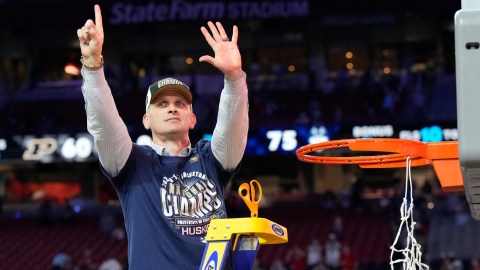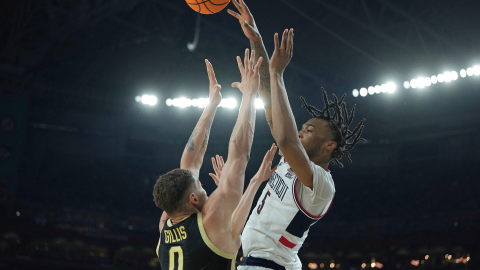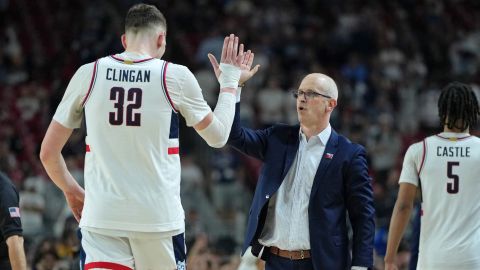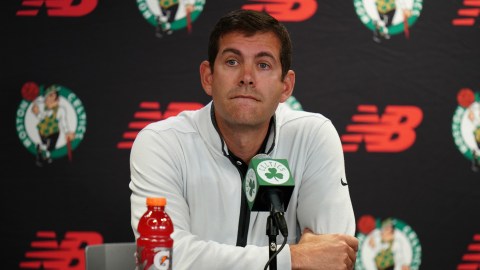Cincinnati — out. WVU — out. St. John's — out. Villanova — out, embarrassingly. Georgetown — out, really embarrassingly. Louisville — out, incredibly embarrassingly. Pitt — out, indescribably.
All of a sudden, the Big East's army of tournament teams has been reduced from a ridiculous 11 down to UConn, Notre Dame, Syracuse, and Marquette — and either the Orangemen or the Golden Eagles won't make it past Sunday either after their match up.
So, how did the 2011 Big East, "the best conference EVER," get here?
Well, it's not as though its deification wasn't based in some facts. Let's track back to the beginning of the season, when Kemba Walker made a mockery of the Maui Invitational, Cincinnati didn't lose for months and Villanova, Pitt, Syracuse and Georgetown dominated out of conference play.
Then, the Big East season began, and everybody started beating up on everybody, Notre Dame dominated, St. Johns started knocking people off — including Duke — and we all came to one conclusion: This is the most dominant conference ever.
Clearly, we missed a few pieces of the puzzle.
So, how did so many of the vaunted Big East Titans fall in the early rounds of the tournament?
First, it should be noted that no Big East team is truly overwhelmingly talented. There's no Kentucky, Kansas, Nort Carolina or Duke in the bunch, and none of the programs could be said to be "at that level" right now. In fact, the conference may even split the talent pool from which it draws too thin, creating a league of great, but not exceptional teams. If you want proof of this recruiting reality, check out the 2010 class rankings, per Rivals — only Syracuse (7), Marquette (14) and UConn (15) cracked the top 25. How many guys are in ESPN's top 50 draft prospects? Only Kemba Walker (10).
Clearly, though, these teams are talented enough to amass quite the bunch of regular season resumes, so recruiting isn't really the issue here. It's something a little more subtle. In years past, there existed a notion that the Pac-10 and ACC were the conferences of guards, but that the Big East was home to size and physicality. That just wasn't the case this season. Few of the teams actually have dominant big men.
For conversation's sake, let's call a dominant big man somebody who scores over 10 PPG and is one of the team's two leading rebounders, with at least 6 RPG. Which Big East tournament teams have such a player? Syracuse — Rick Jackson. WVU — Kevin Jones. Cincy — Yancy Gates. Notre Dame — Tim Abromaitis and Carleton Scott. Honorary mention — UConn — Alex Oriakhi, who is at 9.8-8.7.
Notice something? Those teams either haven't lost, or, as in the cases of WVU and Cincy, lost admirably to teams that just had more talent.
Pitt was vulnerable because there was no DeJuan Blair. Georgetown had no Roy Hibbert. Louisville had no Earl Clark. St. John's got run off the court by Gonzaga because the Zags were so much bigger than the Johnnies.
In the NCAA tournament, when the game slows down, defense improves and every shot is contested, it pays to be able to get consistent scoring in the paint — and to prevent it on the other end. Oddly enough, the Big East teams haven't been able to do that.
The other issue at play with the Big East, though, is a more complex one. Unlike the other major conferences, there is no "signature style of play" that defines the Big East. You'd think that the experience of playing against such a diverse array of styles would be a benefit, but what has actually occurred is that the Big East is just a bizarre amalgam of gimmick teams.
Syracuse — the zone team.
Louisville — the full-court team.
WVU — the physical team.
Pitt — the defensive team that is totally static on offense.
Villanova — the team that shoots threes.
St. Johns — the up-tempo team.
UConn — the team with one great player.
Marquette — the slashing team.
Notre Dame — the jump-shooting team.
What would you call UNC or UK? The teams that run you off the court with talent?
Or Duke or Kansas? The teams with great shooters, senior leadership and defensive discipline?
Comparing the Big East bunch to those teams isn't completely fair, but the reality is that as each Big East team has become so stylistically unique, they've become somewhat one-dimensional. If you also consider that the Big East regular season is now a huge rock-paper-scissors game in terms of each squad's styles matching up, there is nothing but tape showing exactly what style to use against each Big East squad.
In the NCAA tournament, you have to be versatile. Illinois, hailing from the snail's-paced Big 10, went up tempo against a running UNLV team, and the ambush resulted in a blowout. While the conference may be a swiss army knife of styles, each individual Big East team isn't. Do you not think George Mason knew exactly what Villanova was going to do? They took 22 3's, made only seven, conceded 24 free throws at the other end, and lost.
Who knows? Syracuse, UConn and Notre Dame could all make the Final Four, and this weekend's Big East backlash could look ridiculous, but while the reasons for us putting the conference on a pedestal were real, the reasons for their fall from grace are just as legitimate. Whether they are winning or losing simply dictates which truth you want to see.
NESN's college basketball coverage is presented by Bodog.net



